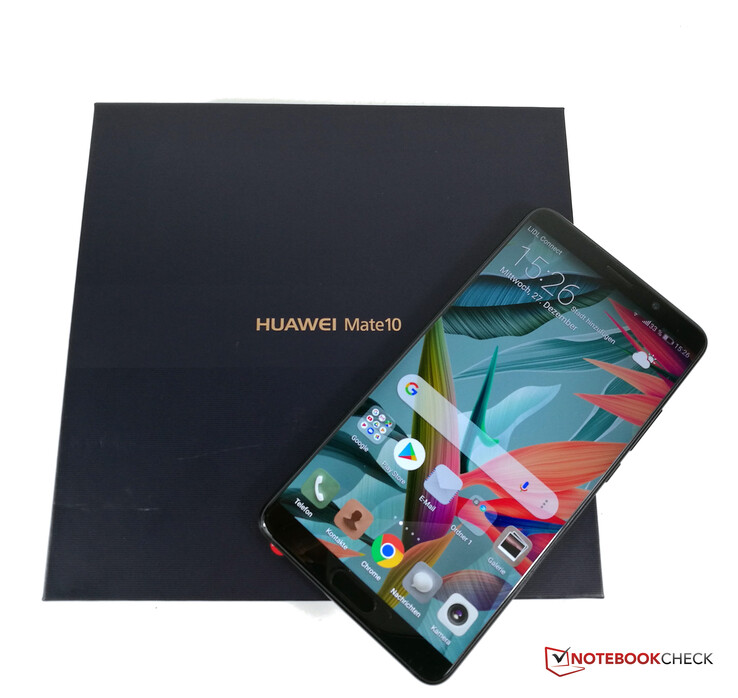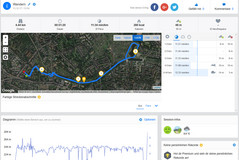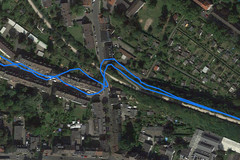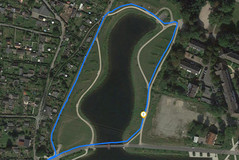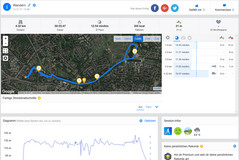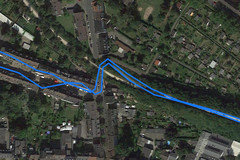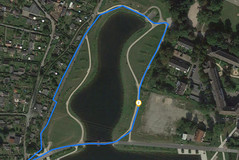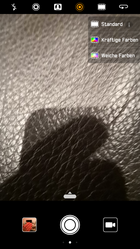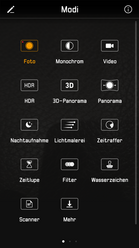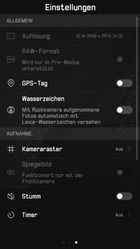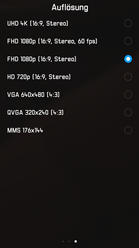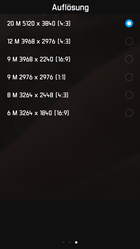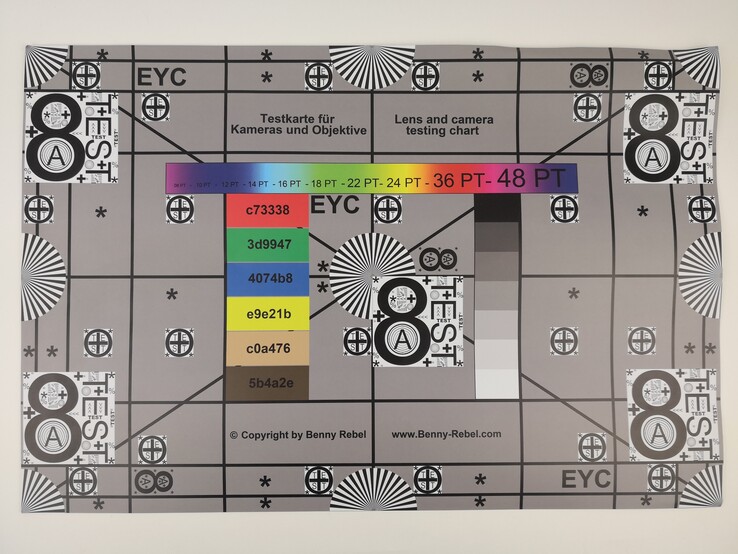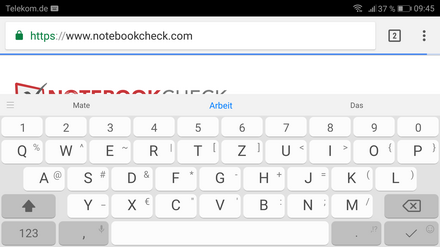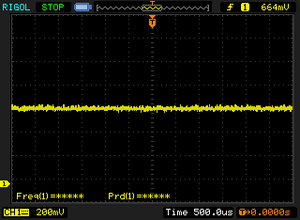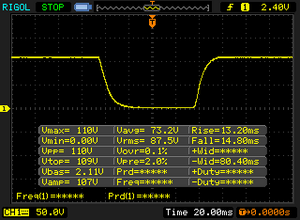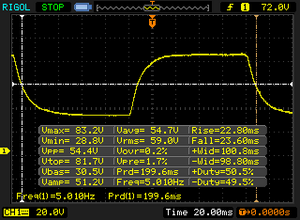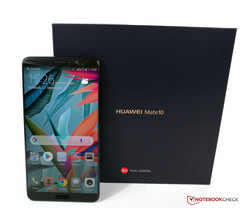Breve Análise do Smartphone Huawei Mate 10
Os Top 10
» Os Top 10 Portáteis Multimídia
» Os Top 10 Portáteis de Jogos
» Os Top 10 Portáteis Leves para Jogos
» Os Top 10 Portáteis Acessíveis de Escritório/Empresariais
» Os Top 10 Portáteis Premium de Escritório/Empresariais
» Os Top 10 dos Portáteis Workstation
» Os Top 10 Subportáteis
» Os Top 10 Ultrabooks
» Os Top 10 Conversíveis
» Os Top 10 Tablets
» Os Top 10 Smartphones
» A melhores Telas de Portáteis Analisadas Pela Notebookcheck
» Top 10 dos portáteis abaixo dos 500 Euros da Notebookcheck
» Top 10 dos Portáteis abaixo dos 300 Euros
Size Comparison
| |||||||||||||||||||||||||
iluminação: 94 %
iluminação com acumulador: 704 cd/m²
Contraste: 2514:1 (Preto: 0.28 cd/m²)
ΔE ColorChecker Calman: 2.4 | ∀{0.5-29.43 Ø4.78}
ΔE Greyscale Calman: 2.8 | ∀{0.09-98 Ø5}
Gamma: 2.34
CCT: 6423 K
| Huawei Mate 10 IPS, 2560x1440, 5.9" | Huawei Mate 9 IPS, 1920x1080, 5.9" | Huawei Mate 10 Pro OLED, 2160x1080, 6" | HTC U Ultra SLCD 5, 2560x1440, 5.7" | Samsung Galaxy Note 8 Super AMOLED, 2960x1440, 6.3" | Samsung Galaxy S8 Plus Super AMOLED, 2960x1440, 6.2" | LG V30 OLED, 2880x1440, 6" | Google Pixel 2 XL P-OLED, 2880x1440, 6" | |
|---|---|---|---|---|---|---|---|---|
| Screen | -45% | 6% | -69% | -12% | 9% | -58% | -20% | |
| Brightness middle (cd/m²) | 704 | 696 -1% | 629 -11% | 470 -33% | 530 -25% | 560 -20% | 432 -39% | 415 -41% |
| Brightness (cd/m²) | 692 | 680 -2% | 636 -8% | 445 -36% | 536 -23% | 562 -19% | 428 -38% | 420 -39% |
| Brightness Distribution (%) | 94 | 93 -1% | 94 0% | 88 -6% | 93 -1% | 93 -1% | 87 -7% | 87 -7% |
| Black Level * (cd/m²) | 0.28 | 0.42 -50% | 0.22 21% | |||||
| Contrast (:1) | 2514 | 1657 -34% | 2136 -15% | |||||
| Colorchecker dE 2000 * | 2.4 | 4.3 -79% | 1.7 29% | 5.5 -129% | 2.6 -8% | 1.7 29% | 4.18 -74% | 2.7 -13% |
| Colorchecker dE 2000 max. * | 4.2 | 9.4 -124% | 3.6 14% | 11.9 -183% | 5.1 -21% | 3.4 19% | 8.53 -103% | 4.3 -2% |
| Greyscale dE 2000 * | 2.8 | 4.8 -71% | 2.4 14% | 7.6 -171% | 2.7 4% | 1.6 43% | 5.3 -89% | 3.3 -18% |
| Gamma | 2.34 94% | 2.33 94% | 2.15 102% | 2.2 100% | 2.04 108% | 2.13 103% | 2.33 94% | 2.36 93% |
| CCT | 6423 101% | 7255 90% | 6337 103% | 7454 87% | 6206 105% | 6435 101% | 7487 87% | 6787 96% |
| Color Space (Percent of AdobeRGB 1998) (%) | 81.57 | |||||||
| Color Space (Percent of sRGB) (%) | 99.87 |
* ... menor é melhor
Cintilação da tela / PWM (modulação por largura de pulso)
| Tela tremeluzindo / PWM não detectado | |||
[pwm_comparison] Em comparação: 53 % de todos os dispositivos testados não usam PWM para escurecer a tela. Se PWM foi detectado, uma média de 8149 (mínimo: 5 - máximo: 343500) Hz foi medida. | |||
Exibir tempos de resposta
| ↔ Tempo de resposta preto para branco | ||
|---|---|---|
| 28 ms ... ascensão ↗ e queda ↘ combinadas | ↗ 13.2 ms ascensão | |
| ↘ 14.8 ms queda | ||
| A tela mostra taxas de resposta relativamente lentas em nossos testes e pode ser muito lenta para os jogadores. Em comparação, todos os dispositivos testados variam de 0.1 (mínimo) a 240 (máximo) ms. » 70 % de todos os dispositivos são melhores. Isso significa que o tempo de resposta medido é pior que a média de todos os dispositivos testados (20.3 ms). | ||
| ↔ Tempo de resposta 50% cinza a 80% cinza | ||
| 46.4 ms ... ascensão ↗ e queda ↘ combinadas | ↗ 22.8 ms ascensão | |
| ↘ 23.6 ms queda | ||
| A tela mostra taxas de resposta lentas em nossos testes e será insatisfatória para os jogadores. Em comparação, todos os dispositivos testados variam de 0.165 (mínimo) a 636 (máximo) ms. » 79 % de todos os dispositivos são melhores. Isso significa que o tempo de resposta medido é pior que a média de todos os dispositivos testados (31.7 ms). | ||
| AnTuTu v6 - Total Score (classificar por valor) | |
| Huawei Mate 10 | |
| Huawei Mate 9 | |
| Huawei Mate 10 Pro | |
| HTC U Ultra | |
| Samsung Galaxy Note 8 | |
| Samsung Galaxy S8 Plus | |
| LG V30 | |
| Google Pixel 2 XL | |
| GFXBench (DX / GLBenchmark) 2.7 | |
| T-Rex Onscreen (classificar por valor) | |
| Huawei Mate 10 | |
| Huawei Mate 9 | |
| Huawei Mate 10 Pro | |
| HTC U Ultra | |
| Samsung Galaxy Note 8 | |
| Samsung Galaxy S8 Plus | |
| LG V30 | |
| Google Pixel 2 XL | |
| 1920x1080 T-Rex Offscreen (classificar por valor) | |
| Huawei Mate 10 | |
| Huawei Mate 9 | |
| Huawei Mate 10 Pro | |
| HTC U Ultra | |
| Samsung Galaxy Note 8 | |
| Samsung Galaxy S8 Plus | |
| LG V30 | |
| Google Pixel 2 XL | |
| GFXBench 3.0 | |
| on screen Manhattan Onscreen OGL (classificar por valor) | |
| Huawei Mate 10 | |
| Huawei Mate 9 | |
| Huawei Mate 10 Pro | |
| HTC U Ultra | |
| Samsung Galaxy Note 8 | |
| Samsung Galaxy S8 Plus | |
| LG V30 | |
| Google Pixel 2 XL | |
| 1920x1080 1080p Manhattan Offscreen (classificar por valor) | |
| Huawei Mate 10 | |
| Huawei Mate 9 | |
| Huawei Mate 10 Pro | |
| HTC U Ultra | |
| Samsung Galaxy Note 8 | |
| Samsung Galaxy S8 Plus | |
| LG V30 | |
| Google Pixel 2 XL | |
| GFXBench 3.1 | |
| on screen Manhattan ES 3.1 Onscreen (classificar por valor) | |
| Huawei Mate 10 | |
| Huawei Mate 9 | |
| Huawei Mate 10 Pro | |
| HTC U Ultra | |
| Samsung Galaxy Note 8 | |
| Samsung Galaxy S8 Plus | |
| LG V30 | |
| Google Pixel 2 XL | |
| 1920x1080 Manhattan ES 3.1 Offscreen (classificar por valor) | |
| Huawei Mate 10 | |
| Huawei Mate 9 | |
| Huawei Mate 10 Pro | |
| HTC U Ultra | |
| Samsung Galaxy Note 8 | |
| Samsung Galaxy S8 Plus | |
| LG V30 | |
| Google Pixel 2 XL | |
| JetStream 1.1 - Total Score | |
| Samsung Galaxy Note 8 (Samsung Browser 6.0) | |
| Huawei Mate 9 (Chrome 54) | |
| Google Pixel 2 XL (Chrome 62) | |
| Samsung Galaxy S8 Plus (Samsung Browser 5.2) | |
| Huawei Mate 10 (Chrome Version 63) | |
| Huawei Mate 10 Pro (Chrome 61) | |
| LG V30 (Chrome 62) | |
| HTC U Ultra (Chrome 56) | |
| Octane V2 - Total Score | |
| Samsung Galaxy S8 Plus (Samsung Browser 5.2) | |
| Samsung Galaxy Note 8 (Samsung Browser 6.0) | |
| Huawei Mate 9 (Chrome 54) | |
| Google Pixel 2 XL (Chrome 62) | |
| Huawei Mate 10 (Chrome Version 63) | |
| LG V30 (Chrome 62) | |
| Huawei Mate 10 Pro (Chrome 61) | |
| HTC U Ultra (Chrome 56) | |
| Mozilla Kraken 1.1 - Total | |
| HTC U Ultra (Chrome 56) | |
| Huawei Mate 10 (Chrome Version 63) | |
| LG V30 (Chrome 62) | |
| Huawei Mate 10 Pro (Chrome 61) | |
| Google Pixel 2 XL (Chrome 62) | |
| Huawei Mate 9 (Chrome 54) | |
| Samsung Galaxy S8 Plus (Samsung Browser 5.2) | |
| Samsung Galaxy Note 8 (Samsung Browser 6.0) | |
| WebXPRT 2015 - Overall | |
| Google Pixel 2 XL (Chrome 62) | |
| Samsung Galaxy Note 8 (Samsung Browser 6.0) | |
| Huawei Mate 10 Pro (Chrome 61) | |
| Huawei Mate 10 (Chrome Version 63) | |
| Samsung Galaxy S8 Plus (Samsung Browser 5.2) | |
| Huawei Mate 9 (Chrome 54) | |
| LG V30 (Chrome 62) | |
* ... menor é melhor
| Huawei Mate 10 | Huawei Mate 9 | Huawei Mate 10 Pro | HTC U Ultra | Samsung Galaxy Note 8 | Samsung Galaxy S8 Plus | LG V30 | Google Pixel 2 XL | |
|---|---|---|---|---|---|---|---|---|
| AndroBench 3-5 | -46% | 8% | -32% | -22% | -23% | -35% | -22% | |
| Sequential Read 256KB (MB/s) | 790 | 594 -25% | 732 -7% | 423.9 -46% | 797 1% | 788 0% | 669 -15% | 760 -4% |
| Sequential Write 256KB (MB/s) | 201.7 | 142.9 -29% | 208.7 3% | 164.7 -18% | 205.9 2% | 194.2 -4% | 193.2 -4% | 195.3 -3% |
| Random Read 4KB (MB/s) | 169.7 | 94.7 -44% | 132.3 -22% | 84.2 -50% | 122.5 -28% | 127.2 -25% | 78.2 -54% | 170.6 1% |
| Random Write 4KB (MB/s) | 105.3 | 8.77 -92% | 164.4 56% | 13.7 -87% | 14.55 -86% | 15.27 -85% | 10.21 -90% | 17.84 -83% |
| Sequential Read 256KB SDCard (MB/s) | 80.6 ? | 54 ? -33% | 82.8 ? 3% | 67.9 ? -16% | 71.1 ? -12% | 62.8 -22% | ||
| Sequential Write 256KB SDCard (MB/s) | 62.9 ? | 29.53 ? -53% | 67.6 ? 7% | 59.3 ? -6% | 57.2 ? -9% | 47.2 -25% |
| Asphalt 8: Airborne | |||
| Configurações | Valor | ||
| high | 29 fps | ||
| very low | 30 fps | ||
| Dead Trigger 2 | |||
| Configurações | Valor | ||
| high | 30 fps | ||
(+) A temperatura máxima no lado superior é 35.3 °C / 96 F, em comparação com a média de 35.2 °C / 95 F , variando de 21.9 a 247 °C para a classe Smartphone.
(+) A parte inferior aquece até um máximo de 35.8 °C / 96 F, em comparação com a média de 34 °C / 93 F
(+) Em uso inativo, a temperatura média para o lado superior é 25.7 °C / 78 F, em comparação com a média do dispositivo de 32.9 °C / ### class_avg_f### F.
Huawei Mate 10 análise de áudio
(+) | os alto-falantes podem tocar relativamente alto (###valor### dB)
Graves 100 - 315Hz
(-) | quase nenhum baixo - em média 21% menor que a mediana
(±) | a linearidade dos graves é média (10% delta para a frequência anterior)
Médios 400 - 2.000 Hz
(+) | médios equilibrados - apenas 4.5% longe da mediana
(±) | a linearidade dos médios é média (7.1% delta para frequência anterior)
Altos 2 - 16 kHz
(±) | máximos mais altos - em média 9.1% maior que a mediana
(+) | os máximos são lineares (4% delta da frequência anterior)
Geral 100 - 16.000 Hz
(±) | a linearidade do som geral é média (23% diferença em relação à mediana)
Comparado com a mesma classe
» 51% de todos os dispositivos testados nesta classe foram melhores, 7% semelhantes, 43% piores
» O melhor teve um delta de 11%, a média foi 35%, o pior foi 134%
Comparado com todos os dispositivos testados
» 68% de todos os dispositivos testados foram melhores, 6% semelhantes, 27% piores
» O melhor teve um delta de 4%, a média foi 24%, o pior foi 134%
HTC U Ultra análise de áudio
(+) | os alto-falantes podem tocar relativamente alto (###valor### dB)
Graves 100 - 315Hz
(-) | quase nenhum baixo - em média 27.3% menor que a mediana
(±) | a linearidade dos graves é média (10.1% delta para a frequência anterior)
Médios 400 - 2.000 Hz
(+) | médios equilibrados - apenas 4.4% longe da mediana
(+) | médios são lineares (6.6% delta para frequência anterior)
Altos 2 - 16 kHz
(±) | máximos mais altos - em média 12.1% maior que a mediana
(+) | os máximos são lineares (6.3% delta da frequência anterior)
Geral 100 - 16.000 Hz
(±) | a linearidade do som geral é média (29% diferença em relação à mediana)
Comparado com a mesma classe
» 76% de todos os dispositivos testados nesta classe foram melhores, 3% semelhantes, 21% piores
» O melhor teve um delta de 11%, a média foi 35%, o pior foi 134%
Comparado com todos os dispositivos testados
» 86% de todos os dispositivos testados foram melhores, 2% semelhantes, 11% piores
» O melhor teve um delta de 4%, a média foi 24%, o pior foi 134%
Google Pixel 2 XL análise de áudio
(+) | os alto-falantes podem tocar relativamente alto (###valor### dB)
Graves 100 - 315Hz
(-) | quase nenhum baixo - em média 28.1% menor que a mediana
(±) | a linearidade dos graves é média (9.5% delta para a frequência anterior)
Médios 400 - 2.000 Hz
(+) | médios equilibrados - apenas 3.2% longe da mediana
(+) | médios são lineares (5.5% delta para frequência anterior)
Altos 2 - 16 kHz
(+) | agudos equilibrados - apenas 3.1% longe da mediana
(+) | os máximos são lineares (4.2% delta da frequência anterior)
Geral 100 - 16.000 Hz
(±) | a linearidade do som geral é média (19.6% diferença em relação à mediana)
Comparado com a mesma classe
» 29% de todos os dispositivos testados nesta classe foram melhores, 8% semelhantes, 63% piores
» O melhor teve um delta de 11%, a média foi 35%, o pior foi 134%
Comparado com todos os dispositivos testados
» 48% de todos os dispositivos testados foram melhores, 7% semelhantes, 45% piores
» O melhor teve um delta de 4%, a média foi 24%, o pior foi 134%
| desligado | |
| Ocioso | |
| Carga |
|
Key:
min: | |
| Huawei Mate 10 4000 mAh | Huawei Mate 9 4000 mAh | Huawei Mate 10 Pro 4000 mAh | HTC U Ultra 3000 mAh | Samsung Galaxy Note 8 3300 mAh | Samsung Galaxy S8 Plus 3500 mAh | LG V30 3300 mAh | Google Pixel 2 XL 3520 mAh | |
|---|---|---|---|---|---|---|---|---|
| Power Consumption | 6% | 25% | -11% | 28% | 35% | 29% | 6% | |
| Idle Minimum * (Watt) | 0.89 | 0.78 12% | 0.85 4% | 1 -12% | 0.73 18% | 0.68 24% | 0.72 19% | 1.28 -44% |
| Idle Average * (Watt) | 2.31 | 2.13 8% | 1.15 50% | 2.41 -4% | 1.44 38% | 1.13 51% | 1.37 41% | 1.87 19% |
| Idle Maximum * (Watt) | 2.38 | 2.17 9% | 1.23 48% | 2.46 -3% | 1.53 36% | 1.16 51% | 1.41 41% | 1.89 21% |
| Load Average * (Watt) | 4.87 | 6.32 -30% | 4.12 15% | 6.8 -40% | 4.56 6% | 4.69 4% | 3.46 29% | 3.73 23% |
| Load Maximum * (Watt) | 9.16 | 6.49 29% | 8.42 8% | 8.9 3% | 5.09 44% | 5.24 43% | 7.83 15% | 8.08 12% |
* ... menor é melhor
| Huawei Mate 10 4000 mAh | Huawei Mate 9 4000 mAh | Huawei Mate 10 Pro 4000 mAh | HTC U Ultra 3000 mAh | Samsung Galaxy Note 8 3300 mAh | Samsung Galaxy S8 Plus 3500 mAh | LG V30 3300 mAh | Google Pixel 2 XL 3520 mAh | |
|---|---|---|---|---|---|---|---|---|
| Duração da bateria | -10% | 11% | -25% | -29% | -10% | -2% | -12% | |
| Reader / Idle (h) | 27.9 | 25.6 -8% | 29.1 4% | 26.1 -6% | 18.9 -32% | 26.1 -6% | 31.9 14% | 28.4 2% |
| H.264 (h) | 16.7 | 15.8 -5% | 15.5 -7% | 10.1 -40% | 11 -34% | 12.4 -26% | 13.7 -18% | 11.2 -33% |
| WiFi v1.3 (h) | 14.4 | 12.6 -12% | 13.6 -6% | 9.1 -37% | 7.9 -45% | 12.3 -15% | 12.9 -10% | 9.7 -33% |
| Load (h) | 4.3 | 3.7 -14% | 6.6 53% | 3.6 -16% | 4.1 -5% | 4.6 7% | 4.5 5% | 5 16% |
Pro
Contra
O Huawei Mate 10 é um excelente smartphone. Algumas poucas restrições - o interruptor de volume frouxo (no nosso caso, pelo menos), a falta de uma certificação IP 67, o ajuste de brilho baseado no contexto, o pós-processamento das fotos - realmente não prejudicam o conceito geral.
O Mate 10 “regular” é, sem dúvida, o sucessor legítimo do popular Mate 9. Como um dos sucessos de 2017, o smartphone certamente é digno de consideração - apesar de não estar oficialmente disponível na Alemanha.
Temos de admitir que nos esforçamos para entender por que a Huawei decidiu não vender o Mate 10 regular na Alemanha e muitos outros países. O phablet possui algumas vantagens sobre a versão Pro: o Mate 10 vem com um conector para fones de 3,5 mm, tem uma resolução QHD, e permite a expansão de armazenamento usando cartões SD. Como tal, deve atrair uma gama de usuários mais ampla. Graças ao formato 16:9, o phablet de 6 polegadas é uma verdadeira alternativa no segmento de gama alta.
Huawei Mate 10
- 01/02/2018 v6 (old)
Marcus Herbrich




